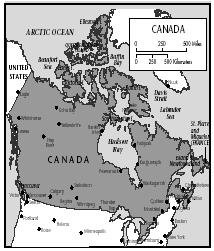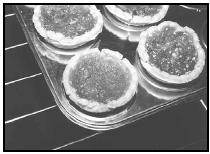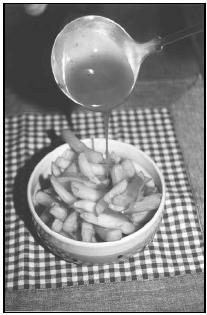Canada French Canadians
Recipes

1 GEOGRAPHIC SETTING AND ENVIRONMENT
Most French Canadians (over 5 million) live in the province of Quebec. Most of the rest (about 1.5 million) live in the other northeastern provinces, known as the "Maritime Provinces" of Canada.
2 HISTORY AND FOOD
There are about 6.5 million French Canadians—descendants of French explorers and colonists—living in Canada. Most French Canadians (over 5 million) live in the province of Quebec. Most of the rest (about 1.5 million) live in the other northeastern provinces, known as the "Maritime Provinces" of Canada. French Canadians who live in the Maritime Provinces are often referred to as Acadians. There are small numbers of French Canadians living in the other provinces and territories, also.
Since the 1960s, interest in preserving French Canadian culture and traditions has grown. French Canadians share many common cultural practices: most are Roman Catholic, most enjoy food, art, music, and activities that began with their French ancestors. In 1974, French was recognized as the official language of Quebec, although English is the official language elsewhere in Canada.
3 FOODS OF THE FRENCH CANADIANS
Probably the best-known French Canadian dish is pea soup. It is enjoyed all over Canada, and is the traditional lunch (called dinner) on Saturday in Newfoundland, usually with dumplings called doughboys floating in it.

French Pea Soup
Ingredients
- 10 cups water
- 2 cup dried yellow peas
- 1 small onion, chopped
- 1 carrot, chopped
- 1 stalk celery, chopped
- 1 potato, cut into bite-sized chunks
- ½ cup diced ham or 2–3 slices cooked bacon, crumbled
Procedure
- Measure peas into a colander and rinse well, picking out any discolored peas or pebbles.
- Measure the water into a saucepan and heat over high heat until the water begins to boil. Add the rinsed peas to the boiling water.
- Lower heat immediately, and simmer peas until they are very soft (about 1 to 1½ hours). Add remaining ingredients and salt to taste and simmer for about 30 minutes longer, until vegetables are tender.
- Make doughboys (if desired; recipe follows), or serve immediately.
Serves 8 to 10.
Doughboys (Dumplings)
These dumplings may be cooked in the pot of pea soup before serving.
Ingredients
- 1½ cups flour
- 1 Tablespoon baking powder
- ½ teaspoon
- ¾ cup water or milk
Procedure
- Combine flour, baking powder, and salt. Gradually add the liquid until a soft dough forms.
- Drop the dough by large spoonfuls into simmering soup, usually pea soup. Cover the pot tightly and simmer for about 15 minutes.
- Serve bowls of soup with one doughboy floating in each bowl.
Makes 8 to 10 servings.
French-Canadian Creton (Spicy Pork Pate)
Creton may be served as an appetizer before a festive meal or as a picnic snack.
Ingredients
- 1 pound ground pork
- 2 onions, chopped
- 2 cloves garlic, minced
- 1 teaspoon cinnamon
- 1 teaspoon cloves
- 1 cup dry bread crumbs
Procedure
- Combine the pork, onions, and garlic in a saucepan and cook over medium-low heat. Simmer, stirring frequently with a wooden spoon, for about one hour.
- Add the cinnamon and cloves and continue simmering for about 20–30 minutes more.
- Add bread crumbs and simmer for about 15 more minutes. (For a spicier mixture, more cinnamon or cloves may be added.)
- Place a colander in the sink, and pour the creton mixture into it to drain off excess liquid. (Rinse the sink thoroughly, because the liquid may contain grease from the meat.)
- Place the cooked creton in several small containers (such as empty margarine tubs or small bowls), packing the mixture down tightly.
- Refrigerate. Serve cold as a spread for French bread or crackers.

Butter Tarts
Ingredients
- Pastry for double crust pie
- ¾ cup raisins
- 1 egg, slightly beaten
- ½ cup brown sugar
- 1 teaspoon vanilla
- ½ cup maple syrup
- ¼ teaspoon salt
- ¼ cup shortening
Procedure
- Preheat oven to 425°F (220°C).
- Roll pastry out on a lightly floured surface. Cut into rounds with 4-inch round cutter. Fit the pastry into medium-sized muffin cups.
- Put raisins into pastry shells, dividing evenly.
- Measure all the other ingredients into a bowl and mix well to make the filling.
- Fill each tart about two-thirds full with filling mixture, covering the raisins. Place muffin tin on bottom shelf of oven, and bake tarts for 12 to 15 minutes or until the filling is set.
- Place tin on a wire rack, and allow tarts to cool. Remove from pan and serve.
Serves 12.
Tarte au Sucre (Sugar Pie)
Ingredients
- Pastry for 9″ pie, or frozen pie crust
- 2 cups brown sugar, firmly packed in the measuring cup
- 2 Tablespoons flour
- Salt
- 2 eggs
- 1 egg yolk (discard egg white or reserve for other use)
- 1 cup milk
- 1 teaspoon vanilla
Procedure
- Roll out pastry and fit into 9″ pie plate, trim and flute edges.
- In bowl, blend sugar, flour, and salt.
- In separate bowl using electric mixer, beat eggs and yolk till frothy; beat in milk and vanilla.
- Stir egg mixture into sugar mixture till smooth. Pour into prepared pie shell.
- Bake in 400°F (205°C) oven for 10 minutes; reduce to 350°F (175°C) and bake for about 35 minutes or till crust is golden brown and filling is set.
- Allow to cool on rack.
Serves 6 to 8.
Pudding au Chomeur (Poor Man's Pudding)
Upside down cake with caramel base.
Ingredients for pudding (cake)
- ½ cup milk
- 3 Tablespoons butter, melted
- 2 teaspoons vanilla
- ¾ cup flour
- 1½ teaspoons baking powder
- ½ teaspoon salt
- 2 eggs
- ¾ cup sugar
Ingredients for sauce
- 1½ cups brown sugar
- ½ cup chopped nuts (optional)
- 2 Tablespoons butter
- Vanilla ice cream as accompaniment (optional)
Procedure
- Preheat oven to 350°F (175°C).
- Make pudding (cake): Combine ½ cup milk, melted butter, and vanilla in small bowl.
- Stir together flour, baking powder, and salt in medium bowl.
- Using electric mixer, beat eggs and ¼ cup sugar in large bowl until thick and fluffy, about 3 minutes.
- Add about one-third of the flour mixture to the egg mixture and stir to combine.
- Next add about one-half of the milk mixture and stir to combine. Continue adding flour and milk, beating well after each addition. Set batter aside.
- Make caramel sauce: Combine brown sugar and butter in a small saucepan and cook over low heat until butter melts and sugar dissolves completely.
- Pour sauce into an 8-inch-diameter ceramic soufflé dish.
- Spoon cake batter over brown sugar mixture in soufflé dish. Bake until tester inserted into center of cake comes out clean and syrup is bubbling at edges, about 40 minutes.
- Serve hot with vanilla ice cream.
Makes 6 to 8 servings.
4 FOOD FOR RELIGIOUS AND HOLIDAY CELEBRATIONS
French Canadians celebrate holidays related to the Roman Catholic Church, especially Easter and Christmas. On Christmas Eve, families traditionally attend a religious service called a Mass (many attend Midnight Mass), followed by a festive holiday meal. One of the traditional dishes is a spicy meat pie called a tourtière , made on Christmas Eve using ground pork.
Tourtière (Meat Pie)
Ingredients
- 2 Tablespoons vegetable oil
- 1½ pounds ground meat (traditionally pork for Christmas Eve)
- 1 onion, chopped
- ½ teaspoon allspice
- ½ teaspoon ground cloves
- ½ teaspoon ground cinnamon
- 1 Tablespoon Worcestershire sauce
- 2 potatoes, grated
- Salt and pepper to taste
- Pastry for double crust pie (may use prepackaged pie crust)
Procedure
- Preheat oven to 375°F (190°C).
- Prepare pastry (may use frozen or prepackaged pie crust; recipe appears below).
- Fit crust into pie plate and set aside.
- Measure oil into a large skillet. Heat over medium heat for about 1 minute. Add onions and meat.
- Cook until meat has lost all its pink color. Add allspice, cloves, cinnamon, Worcestershire sauce, and grated potatoes. Mix well, using a wooden spoon. Let simmer 5 minutes.
- Fill pastry shell and cover with second crust.
- Bake 30 minutes (until crust is golden). Serve hot. May be topped with ketchup or chili sauce.
Serves 6 to 8.
On February 2, French Canadian Roman Catholics celebrate the Fête de la Chandeleur (Candlemas), honoring the day in the church calendar when Mary took the baby Jesus to the temple, by eating crêpes (thin pancakes). A traditional French Canadian proverb says "Manger des crêpes à la chandeleur apporte un an de bonheur" (Eating crêpes on Candlemas brings a year of happiness).
Crêpes de la Chandeleur (Candlemas Pancakes)
Ingredients
- 1 cup flour
- ½ teaspoon baking powder
- ½ teaspoon baking soda
- ½ teaspoon salt
- 2 eggs
- ¾ cup milk
- Vegetable oil
Procedure
- Break eggs into a large mixing bowl and beat with a wire whisk.
- Measure flour, baking powder, baking soda, and salt into another bowl and stir to combine. Add gradually to egg mixture.
- Add milk gradually, continuing to stir with the wire whisk. The batter should be smooth, with no lumps.
- Pour oil into an 8-inch skillet to cover the bottom. Heat the oil over medium-high heat.
- Using a soup ladle, carefully pour a ladleful (about ¼ cup) of the batter into the hot oil. Tilt the pan carefully to spread the batter into a large, thin crêpe that covers the bottom of the skillet.
- Cook until the crêpe is golden brown on the bottom (about 3 to 4 minutes).
- Carefully flip the crêpe over to cook the other side. Remove crêpe from pan, and blot on paper towel to remove excess oil.
- Serve with maple syrup.
Serves 8 to 10.
5 MEALTIME CUSTOMS
French Canadians may eat a pastry, such as a croissant, for breakfast, accompanied by coffee or tea. For those with time for a heartier breakfast, eggs with Canadian bacon or sausage accompanied by toast and coffee. Lunch may be a ham and cheese sandwich made on crusty French-style or whole grain bread. Pea soup, served at home and in restaurants, is a favorite hearty weekend meal. Dinner may be ragoût de boulettes (spicy meatballs) or other meat dish, accompanied by potatoes, usually with gravy. Polite diners never put their elbows on the table until the meal is finished. Men may rest their forearms on the table, but women typically just hold their wrists against the table's edge while dining.
In Quebec street vendors and restaurants sell a quick snack called poutine. Poutine is French fries smothered in gravy and sometimes with melted cheddar cheese curds. Although this is not considered a traditional French Canadian food, poutine is a very common and popular snack or accompaniment to a casual meal everywhere in Quebec.
Ragoût de Boulettes (Spicy Meatballs)
Ingredients
- ¾ cup flour
- ¾ cup onion, chopped
- 1 Tablespoon olive oil
- 2 pounds ground pork (or combination of 1 pound ground pork and 1 pound ground beef or veal)
- ½ teaspoon cinnamon
- ½ teaspoon nutmeg
- ½ teaspoon ground cloves
- 1 teaspoon salt
- ¼ teaspoon pepper
- 3 cans beef broth (about 6 cups)
Procedure
- Make browned flour: Measure the flourinto a large skillet and heat over low heat. Stir frequently until flour is slightly browned. Set aside.
- Measure oil into a skillet and heat over medium-high heat. Add chopped onions and cook, stirring frequently, until onions are translucent.
- In a large mixing bowl, combine cooked onions, ground meat, and seasonings. With very clean hands, combine meat and seasonings thoroughly.
- Shape meat mixture into meatballs about 1½ inches in diameter.
- Pour broth into a large saucepan and heat to boiling. Drop meatballs into boiling stock, lower heat, and simmer about 1½ hours. (Cover pan with the lid slightly offset to allow some steam to escape.)
- Sprinkle in the browned flour, a little at a time, stirring with a wooden spoon, until gravy thickens.
Serves 8 to 10.
Quebec Poutine
Ingredients
- 1 bag frozen French fries
- 8 ounces shredded cheddar cheese
- 1 jar beef or onion gravy (or packet of gravy mix)

Procedure
- Prepare French fries in the oven according to the instructions on the package.
- While the French fries are cooking, pour the gravy into a saucepan and heat it to just bubbling.
- Remove the French fries from the oven, scatter shredded cheddar cheese over them, and return them to the oven for one minute, just long enough to melt the cheese.
- Transfer the cheese-covered French fries to invidual plates or bowls, and drizzle with the gravy.
Serves 8 to 10.
6 POLITICS, ECONOMICS, AND NUTRITION
A major concern of French Canadians is the preservation of their French language and culture, since English is the dominant language in the rest of Canada and in their influential southern neighbor, the United States. A movement to separate the French-speaking province of Quebec from the rest of the country became a national issue in the 1970s; in 1980, voters defeated a proposal that would have granted Quebec its independence from Canada, but many French-Canadian separatists continue the campaign.
Canadians in general receive adequate nutrition in their diets, and the health care system is funded by the government, covering about 75 percent of health care costs for Canandian families.
7 FURTHER STUDY
Books
Barbolet, Herb. Farm Folk, City Folk: Stories, Tips, and Recipes Celebrating Local Food for Food Lovers of All Stripes. Vancouver: Douglas & McIntyre, 1998.
Barer-Stein, Thelma. You Eat What You Are: People, Culture, and Food Traditions. 2nd ed. Toronto: Firefly Books, 1999.
Chavich, Cinda. The Wild West Cookbook. Don Mills, Ont.: R. Rose, 1998.
Claman, Marcy. Rise & Dine Canada: Savory Secrets from Canada's Bed & Breakfast Inns. 2nd ed. Montreal, Quebec: Callawind Publications, 1999.
London, Jonathan. The Sugaring-Off Party. New York: Dutton, 1994. [Picture-book account of maple sugaring in Canada.]
Stewart, Anita. Great Canadian Cuisine: The Contemporary Flavours of Canadian Pacific Hotels. Vancouver, BC: Douglas & McIntyre, 1999.
Tritenbach, Paul. Traveling Taste Buds: Delectable Dishes from All Over the US and Canada. Bishop, CA: Excellence Press, 2000.
Web Sites
Always Canadian. [Online] Available http://www.alwayscanadian.com (accessed August 15, 2001). Online source of Canadian products.
Root, Lorna. "Food and More: Canadian Cuisine." [Online] Available http://www.geocities.com/lorna_lynne/recipes/recipe1.html (accessed April 17, 2001).
Hopefully you can find everything to make these dishes as they can be wuite yummy. Thank you for the article
We also ate a ton of oatmeal and put a drizzle of maple syrup on it. No self-respecting Frog would have Mrs. Butterworth's in the house. Actually, real maple syrup is a bargain because you need so much less of it than the fake sirops.